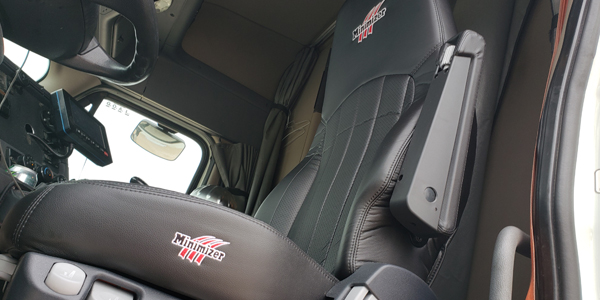Being tired on the job is a reality for many people, but when a truck driver is suffering from fatigue, there can be dire consequences. While there is no agreement on how to directly measure fatigue in accidents involving trucks, the National Transportation Safety Board estimates that fatigue played a role in 20% of the truck-related accidents they investigated in 2015.
Let’s look a little more closely at what that means. According to the Federal Motor Carrier Safety Administration, there were 4,050 accidents involving large trucks in 2015. There were also 87,000 injury crashes in 2015 and 342,000 crashes involving property damage. From 2014 to 2015, large truck and bus fatalities per 100 million vehicle miles traveled by all motor vehicles increased 1.7 percent, the agency says. Interestingly, 60 percent of fatal crashes involving large trucks occurred on rural roads.
There are several reasons why a person may become fatigued while driving, including a lack of sleep, poor health, a pre-existing medical condition, driving too many hours without a break, and even the physical stress of driving. The constant vibrations of the road get transmitted to the driver’s body and have a fatiguing effect.
A tired driver is less alert, has slower reaction times, and is less able to think clearly and process information efficiently, leading to poor decision-making. The safe operation of a motor vehicle requires drivers to be alert and awake and “to have situational awareness and appropriately timed psychomotor and cognitive responses,” according to Commercial Motor Vehicle Driver Fatigue, Long-Term Health & Highway Safety.
FMCSA offers commercial vehicle drivers tips for reducing fatigue, starting with enough sleep before getting behind the wheel. While that may be easier said than done, given the busy lives we all lead, the National Sleep Foundation recommends adults get seven to nine hours of sleep each night.
FMCSA also advises maintaining a healthy diet. “Skipping meals or eating at irregular times may lead to fatigue,” the organization says. FMCSA also encourages drivers to recognize drowsiness signs, including frequent yawning, heavy eyes, and blurred vision. Furthermore, the agency says turning up the radio, drinking coffee, and opening the windows are not actual cures for drowsiness and may give the driver a false sense of security.
Even if a driver conforms to Hours of Service requirements, begins his trip well-rested, and leads a healthy lifestyle, the very fact that he is spending 10 hours driving can take a physical toll.
Truck drivers are subjected to something called whole body vibration. Whole body vibration is defined as a mechanical wave that manifests as the energy transfer from the vehicle traveling on the road surface to the driver. In other words, the driver absorbs the vibration of the road. Those vibrations take their toll on a driver’s body in the form of fatigue and other physical issues, especially those related to the spine.
Additionally, Doctor of Chiropractic Michael Peterson says sitting for prolonged periods “does not allow the lymphatic [system] to drain out the toxicity that can be created with the option to shift around, which a truck driver does not have. This can affect lymphatic drainage and vasculature, which can have long-term effects on your heart and your cardiovascular health.”
In fact, according to Joseph Sweere, DC, DABCO, DABCOH, FICC, “Statistics show that the trucking industry has one of the very highest incidents and severity of spine disorders.”
In an article in Transport Topics, Peter Johnson, a professor in the Occupational and Environmental Exposure Sciences program in the School of Public Health at the University of Seattle, is quoted as saying, “A number of scientific studies have shown an association between exposure to vehicle-related whole body vibration and the development of health problems.”
One fundamental way to help improve the driver experience and reduce the road’s impact on the driver is by correctly supporting the body while driving. The proper seat — properly adjusted — with the right features can go a long way toward mitigating the effects of whole body vibration and other physical stresses of driving.
At their most basic level, a good seat must allow the driver to make adjustments for height, horizontal position, and the backrest’s recline angle. According to Dr. Sweere, adjustability is the key. Ergonomically-designed seats lessen the effect of vibration on the driver and help prevent the onset of fatigue.
Dr. Peterson adds, “If the driver is shifting positions all the time, it puts traction on the nerve root, and that leads to long-term problems.”
It makes sense that the seating needs of a six-foot-four, 280-pound male driver are different than those of a five-foot-six, 112-pound female driver. “Their body proportions are different,“ Dr. Sweere says, so they need to have the driver’s seat adjusted differently for maximum support and comfort.
Having an adjustable seat should make the driving experience more comfortable and help reduce drowsiness and fatigue. Coupling the proper seat with the recommended amount of sleep, a healthy diet, and driving only during legal Hours of Service should lead to
reduced fatigue.
Dr. Sweere says that sitting for long periods causes the accumulation of fluids. “Anything that can be done to facilitate the reduction of that or to mobilize it [is beneficial.] One of the very best ways to do that is with movement,” Dr. Sweere says.
A massaging feature on the seat, turned on about 20 minutes before a driver plans to exit the vehicle, helps disperse fluids and loosen up the driver’s muscles. However, training drivers on seat functions and making proper adjustments is imperative to seat effectiveness.
This article was sponsored by Minimizer. For more information, please visit www.minimizer.com















